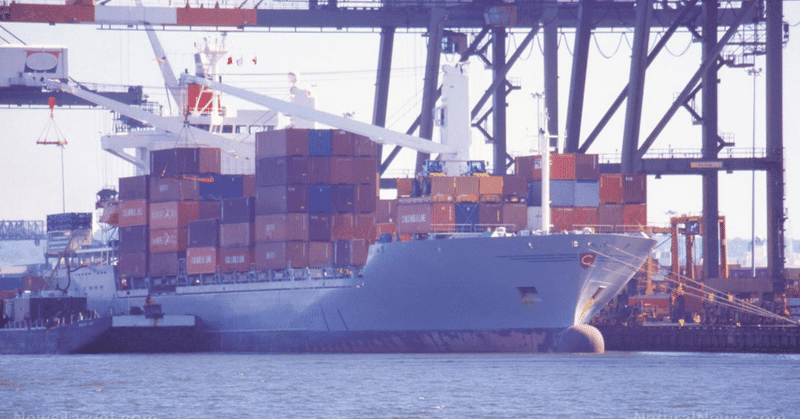
ディープ・ステートが気付き出した米国の崩壊 その5
ウォルマート、UPS、フェデックスは、世界的な供給障害に対処するため、より多くのシフトで働くことを約束します...しかし、それは重要なことでしょうか?
2021年10月18日(月) by: Mary Villareal
(Natural News) ホワイトハウスは10月13日(水)、ウォルマート、UPS、フェデックスの3社が、インフレ高騰の一因となっている世界的な供給障害に対処するため、より多くのシフトで働くように動いていることを発表しました。この発表は、ジョー・バイデン大統領がクリスマスシーズンを前にサプライチェーンのボトルネックに対処するため、これらの企業のトップと会談するのに先立って行われました。
クリスマス商戦の売上が予想を下回ると、米国企業に打撃を与え、結果的にバイデン氏にとっては政治的リスクとなります。
バイデン政権が発表したファクトシートによると、ウォルマートは「夜間の利用を増やす」としており、今後数週間で処理能力が50%も向上すると予測しています。
UPSは、24時間365日体制のオペレーションと「港とのデータ共有の強化」により、より多くのコンテナを港から搬出するとしています。フェデックスは、夜間の営業時間の増加とトラックや鉄道の利用方法の変更を組み合わせて、港から移動できるコンテナの量を増やす努力をするとしています。
2020年には、UPSとFedExの合計で、米国の荷物の約40%を出荷することになります。ホワイトハウスの関係者が水曜日に報道機関に語ったところによると、フェデックス、UPS、ウォルマートの3社は、24時間365日の勤務体制に移行するとのことです。
このスケジュールでは、年末まで週に3,500個以上のコンテナを夜間に追加で移動することができます。「これらのコンテナには、米国人がオンラインや地元の小規模なビジネスで購入した玩具、家電製品、自転車、家具、そして米国の工場に送られ、労働者が製品に組み立てるための部品やパーツが入っています」とホワイトハウスのファクトシートに記載されています。
ロサンゼルス港も24時間365日のサービスに移行します。一方、国際港湾倉庫労組も24時間365日の人員配置を受けることを約束しました。これは、"貨物が埠頭から高速道路に移動できる時間 "を2倍にすることを意味しています。ロングビーチ港では、数週間前に同様のノンストップオペレーションを開始しています。
COVID-19のパンデミックが進行する供給危機
現在進行中の供給危機は、労働者不足や交通機関のハブ機能の低下の中で商品の販売が増加したため、武漢コロナウイルス(COVID-19)のパンデミックが大きく影響しています。
沖合の貨物船には数千個の輸送用コンテナが積み込まれ、港での荷降ろしを待っています。同様に、ニューヨークやジョージア州サバンナの港でもバックログが存在する。また、商品をピックアップできる倉庫用トラックのドライバーが不足していることも、ボトルネックの原因となっています。(関連記事 世界経済の回復を脅かす海運コストの高騰と港湾のボトルネック)
大統領は演説の中で、米国が物資や材料の不足により重要な製品を作れなくなることは「二度とない」と述べています。「特に、労働基準や環境基準に関して我々と価値観を共有していない国に対しては、二度と一企業、一国、一個人に過度に依存してはならない」と述べています。
労働者不足やCOVID-19の発生により、輸送港での物流が滞っているため、アジアから米国に製品が届くまでの時間が2倍になっています。数ヶ月前から続いていた遅延のため、小売業者はボトルネックを解消するために奔走し、中にはホリデーシーズン前に問題を回避するために独自の貨物船をチャーターするケースもありました。
しかし、政府高官によると、市場がサプライチェーンと労働者不足の問題を解決するために、消費者は年内はまだ価格の上昇や商品の不足を余儀なくされる可能性があるとのことです。
6月に主要セクターのサプライチェーンの課題に対処するためのタスクフォースを設立すると発表したホワイトハウスは、「住宅建設・建築、半導体、輸送、農業・食品」に焦点を当て、商務・農業・輸送の各長官が主導するとしています。
経済危機に関する最新情報は、Bubble.newsでご覧いただけます。
ソースは以下の通りです。
TheEpochTimes.com
NBCNews.com
原文:
Walmart, UPS and FedEx commit to working more shifts to deal with global supply disruptions… but will it matter?
Monday, October 18, 2021 by: Mary Villareal
(Natural News) The White House announced Wednesday, Oct. 13, that Walmart, UPS and FedEx are moving to work more shifts to deal with global supply disruptions that have contributed to a surge in inflation. The announcement was made ahead of President Joe Biden’s meeting with the heads of those companies to address the supply chain bottlenecks before the Christmas season.
Lower-than-expected Christmas sales could hurt U.S. companies and consequently pose a political risk for Biden.
A fact sheet released by the Biden administration notes that Walmart will “increase its use of night-time hours,” projecting that the company could increase throughput by as much as 50 percent in the next several weeks.
UPS says it will use its 24/7 operations “and enhanced data sharing with the ports” around the country to move more containers out of ports. FedEx says it will work to combine an increase in nighttime hours with changes to the trucking and rail use to increase the volume of containers it can move from ports.
In 2020, UPS and FedEx combined to ship approximately 40 percent of U.S. packages by volume. A White House official told news outlets on Wednesday that FedEx, UPS and Walmart will move toward a 24/7 working schedule.
With that schedule, over 3,500 additional containers can be moved per week at night through the end of the year. “Those boxes contain toys, appliances, bicycles and furniture that Americans purchased online or at their local small business, and pieces and parts that are sent to U.S. factories for our workers to assemble into products,” the White House fact sheet states.
The Port of Los Angeles will also move to 24/7 service while the International Longshore and Warehouse Union has also made a commitment to undergo 24/7 staffing, meaning that it will double the “hours that cargo will be able to move out of its docks and onto highways.” The Port of Long Beach began similar non-stop operations several weeks ago.
COVID-19 pandemic drives ongoing supply crisis
The ongoing supply crisis is largely driven by the Wuhan coronavirus (COVID-19) pandemic as sales of goods increased amidst worker shortages and transportation hub slowdowns.
Thousands of shipping containers are on cargo ships offshore, waiting to be offloaded at the ports. Similarly, backlogs exist at ports in New York and Savannah, Georgia. The shortage of warehouse truck drivers who can pick up goods is yet another reason for bottlenecks. (Related: Surge in shipping costs, bottlenecks at ports threaten global economic recovery.)
The president says in a speech that the U.S. will “never again” be unable to make critical products due to lack of supplies and materials. “Never again should we have to rely too heavily on one company or one country or one person in the world, particularly when countries don’t share our values when it comes to labor and environmental standards,” he says.
Logistical backups at shipping ports due to worker shortages and COVID-19 outbreaks have doubled the time for products to make their way from Asia into the United States. The delays, which had been going on for months, have sent retailers scrambling to address the bottlenecks, in some cases going so far as chartering their own private cargo vessels to get around problems before the holiday season.
However, according to top administration officials, consumers could still see higher prices and product shortages through the rest of the year as the market works through the supply chain and worker shortage crises.
The White House, which announced in June that it will establish a task force to address supply chain challenges in key sectors, says that it will focus on “homebuilding and construction, semiconductors, transportation, agriculture and food,” and will be led by the secretaries of commerce, agriculture and transportation.
Get more updates about the economic crisis on Bubble.news.
Sources include:
TheEpochTimes.com
NBCNews.com
この記事が気に入ったらサポートをしてみませんか?
